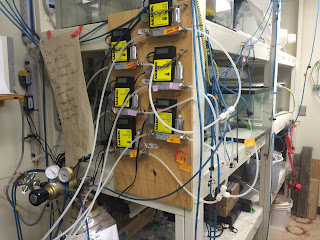To settle

Friends, as I've mentioned, there are some experiments going on in my lab at WHOI right now to examine how oyster larvae behave in different environmental conditions. Students and interns in the Mullineaux lab have been working on oyster behavior for several years now, in an effort to understand how turbulence, light, and water chemistry affect the swimming behavior of oyster larvae. This mess of tubes is channeling compressed gas into our flasks of seawater. This year, our question is how ocean acidification influences the behavior of oyster larvae when they're ready to settle and begin adult life on the seafloor. Settlement is a critical stage in the life-cycle of marine animals, and swimming larvae use a variety of physical and chemical cues to select the best place on the seafloor to attach, metamorphose, and spend the rest of their life. However, as the concentration of carbon dioxide in the atmosphere rises, more and more CO 2 is becoming dissolved in the ocean,
